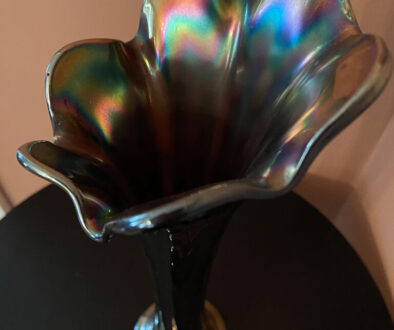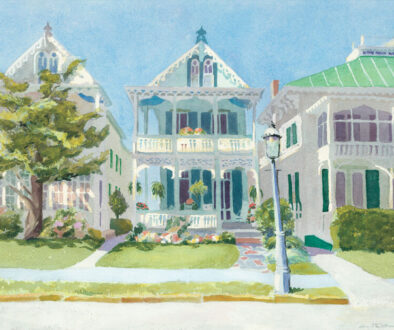The Re-emergence of Wallpaper
Like most trends, things in the interior design world tend to be cyclical. From paint colors and building materials, things fall in—and out—of favor only to come back around a few decades later. And while wallpaper itself isn’t anything new, the way we use it, the way we make it, and the prints available make it particularly user-friendly in 2024.
According to BBC.com, wallpaper, in the form of decorated rice paper, was first developed in China, all the way back in the Qin dynasty (221-206 BC). It took quite some time to make it to Europe before finally arriving in America in 1739. While none of our readers were around back then, many of them—this writer included—can vividly remember the wallpaper heyday of the late 1970s and early 1980s, when everything from yellow and lime green plaid to multiple patterns and borders might grace a single room.
With such an abundance of color, pattern, and use—it seemed to be ubiquitous—it’s no wonder that the pendulum eventually swung the other way, and the minimalism of a single paint color became the standard bearer of style. Until of course, it didn’t. We spoke with artist and interior designer Erin Daniels about the re-emergence of wallcoverings and how this newest iteration differs from the wallpaper designs of the past.
“People are using it a little more selectively than they did in the past,” says Daniels. “They’re not wallpapering a whole house. They’re putting it in one room, maybe in a dining room, giving it more impact. Another change that’s a bit of a trend is to do a bold wallpaper on the ceiling.”


Other trends include the patterns of the wallcoverings themselves. Though homeowners and designers can find just about everything—likely including that yellow and lime green plaid from the 70s—there are specific motifs that are particularly popular. In addition to florals, which are hugely in favor, Daniels has seen a resurgence of hand blocked wallpaper, metallics, and grass cloth wall coverings.
“The florals of today are updated from the past,” says Daniels. “Some are large print; the colors are more edgy. It’s not the pink and seafoam green of the 80s, it’s a more dramatic contrast.”
Even toile designs, which have historically depicted stories, or narrative vignettes, that represented rural life and historical events, have taken a turn towards modernity, with artists providing their own interpretations and commentaries. Daniels explains that artist Sheila Bridges does a story toile of the south, creating an updated design that serves as a cultural statement piece.
The difference now isn’t just the pattern of wallcoverings. In fact, the way wallpaper is made has opened the floodgates to customization and accessibility—the options are literally endless.
“I would say that digital printing has changed the entire business of wallpaper,” says Daniels. “In the past, you had to buy what the companies had in stock on rolls. Now you can do custom coloring pretty easily and cost effectively. You can do metallic. You can use peel and stick wallpapers, which aren’t particularly high end but great for a space if you’re renting because it’s removable.”
While there are people that still create beautiful hand printed wallpapers, digital printing has changed the wallcovering landscape in terms of affordability and accessibility. Digital printing has also opened the door for visual artists to create their own wallpaper designs based on their artwork.
“It’s becoming fairly popular for artists to create a wallpaper design, depending on their skill level. You have to make sure the design will repeat well, because you’re designing on paper and you have to ensure it flows nicely,” says Daniels. “When I created my wallpaper, I worked with a pattern designer who put it into repeat so it would flow nicely across the room.”
In addition to digital printing, there’s a new emphasis on texture and materials. No longer are we relegated to the substrates of the past. These days, the materials that wallpaper is printed on can vary greatly from those with vinyl, pvc, or petroleum to environmentally friendly options like true paper, available in varying thicknesses, matte, shiny, pearlescent and more, with different options available for different uses.
“If you have a design and you want it on a building with fire codes, you have to have a different substrate than what you might use at home,” says Daniels. “Wherever you’re getting your wallpaper from, you should be able to tell them what it’s for, so they can give you the appropriate type of paper. For example, my wallpaper, which is printed on paper, wouldn’t be appropriate for a steamy or high moisture situation.”
While so many options might entice readers to jump on the wallpaper trend, there are some things to consider. If the 70s and 80s taught us anything, it’s that too much of a good thing is simply too much.
“I would say if you’re going to use a statement wallpaper, keep it to one room,” says Daniels. “If you’re going to use a statement wallpaper in your dining room, let that be it for the first floor of the house. Adding any other wall coverings dilutes the effects of the boldness of it. Consider it a piece of art—it’s the focal point.”
Likewise, don’t be afraid to wallpaper a small space, like a powder room. Rather than lamenting that wallpaper can make a room feel smaller, recognize that a small room is just that, and play up the coziness or intimacy of the space.
And while the rules of wallcoverings aren’t hard and fast, Daniels does have two suggestions that can make or break any wallpaper experience. The first is to make sure you ask for samples before ordering anything.
“If you have to, buy the sample, because you will have huge variations in the paper quality,” says Daniels. “Be able to feel it, whether you’re going to sites to look or searching through big brand books, get a sample.”
Finally, hire a professional. While we all admire that DIY attitude, there are some things that require expertise, and hanging wallpaper appears to be one of them.
“I recommend that homeowners have a professional paper hanger measure the space and hang the paper,” says Daniels. “I think you get a much better result with a professional because not only will you order the correct amount of wallpaper, but they will be able to match the seams and the pattern. Especially if you’re using wallpaper as a mural, where each panel is a little bit different. There’s no leeway. Pay someone to hang it. I can’t recommend a professional enough.”



